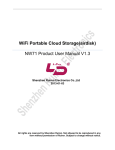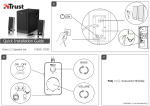Download aJ-Orion User Manual for Android - aJile Security
Transcript
aJ-OrionTM User’s Manual October 25, 2012 Version 5.3 aJ-Orion Home Security System aJile Systems, Inc. © Copyright aJile Systems, Inc. 2012 All Rights Reserved. aJ-Orion is a trademark of aJile Systems, Inc. Google and Gmail are trademarks of Google Inc. in the United States and other countries. All other trademarks are the property of their respective owners. All information in this document is subject to change without notice. The information contained in this document does not affect aJile Systems’ product specification or warranties. Nothing in this document shall operate as license or is with express or implied warranty. THE INFORMATION CONTAINED IN THIS DOCUMENT IS PROVIDED ON AN “AS IS” BASIS. In no event will aJile Systems be liable for damages arising directly or indirectly from any use of the information contained in this document. aJ-Orion User Manual Table of Contents Chapter 1: Overview 1.1. Warranty ...........................................................................................1 ......................................................................................................................... 2 Chapter 2: Setup and Configuration 2.1. 2.2. 2.3. 2.4. 2.5. 2.6. .................................................................3 Getting Started ................................................................................................................ 3 aJ-Orion Client Application Installation ......................................................................... 3 aJ-Orion Client Application Setup Procedure ................................................................ 4 aJ-Orion Device Setup .................................................................................................... 6 aJ-Orion Client Application Startup Procedure .............................................................. 6 aJ-Orion Message Settings Options ................................................................................ 7 Chapter 3: Operations ........................................................................................8 3.1. Status ............................................................................................................................... 8 3.2. Alerts ............................................................................................................................... 9 3.3. Monitoring .................................................................................................................... 10 3.4. Viewing Missed Alerts ................................................................................................. 11 3.5. Viewing Missed Images ................................................................................................ 12 3.6. Console ......................................................................................................................... 13 3.6.1. WLAN Signal Strength ......................................................................................... 13 3.7. Refresh Connection ....................................................................................................... 13 Appendix A: FAQs and Trouble Shooting ......................................................14 A.1. FAQs ............................................................................................................................. 14 A.1.1. Are image list if an alert is missed? ...................................................................... 14 A.1.2. How can previously received images be viewed? ................................................ 14 A.1.3. How many images can be stored on the aJ-Orion device? ................................... 14 A.2. Video playback and streaming video ............................................................................ 14 A.2.1. Video player compatibility ................................................................................... 14 A.2.2. Streaming video port forwarding .......................................................................... 14 A.3. Trouble Shooting .......................................................................................................... 15 A.3.1. aJ-Orion client application popup message “Unable to connect to aJ-Orion” ...... 15 A.3.2. aJ-Orion client application status shows “Not connected to Server” ................... 15 A.3.3. aJ-Orion application status shows “Not connected to aJ-Orion” .......................... 15 A.3.4. aJ-Orion application shuts down. .......................................................................... 16 A.4. Revising system settings ............................................................................................... 16 A.4.1. Changing server accounts ..................................................................................... 16 A.4.2. Changing network configuration .......................................................................... 17 C o p y r i g h t © 2012 aJile Systems, Inc. All rights reserved. ii aJ-Orion User Manual CHAPTER 1:OVERVIEW The aJile aJ-Orion Home Security System is a compact portable network security device that detects intrusion, captures intruder's image, and sends alerts to an application on a smart phone. The aJile security device is based on a unique patented intrusion technology that can detect intrusion into a premises with a floor space up to 2000 SF in an enclosed environment. It also combines an integrated image capture, JPEG image compression, and flexible network capability including LAN, WIFI and optional cellular Edge/GPRS into a single box. It's a portable security system that moves with you, and travel with you if you move to a new place. It just requires a simple installation, and will adapt to your new place quickly and easily. The aJ-Orion is intended for apartments, condos, small houses, offices, retail shops, mobile homes, containers, and boats/yachts The aJ-Orion Home Security System consists of the following components as shown in Figure 1-1 below. aJ-Orion Home Security Device Ethernet Crossover Cable Power Adapter Figure 1-1: aJ-Orion Home Security System The aJ-Orion Home Security System requires the user to provide a WIFI capable smart phone (Android or iPhone) with data service plan (3G recommended). C o p y r i g h t © 2012 aJile Systems, Inc. All rights reserved. 1 aJ-Orion User Manual 1.1. Warranty aJile Products warrants to you, the original purchaser of this Product, that this product shall be free of defects in material or workmanship for the Warranty Period of one (1) year as follows: 1. LABOR: During the Warranty Period if this Product is determined to be defective, Insignia will repair or replace the Product, at its option at no charge, or pay the labor charges to any aJile authorized service facility. After the Warranty Period, you must pay for all labor charges. 2. PARTS: In addition, aJile will supply, at no charge, new or rebuilt replacement parts in exchange for defective parts for the Warranty Period. After the Warranty Period, you must pay all parts costs. To obtain warranty service, you must take the Product with your original receipt or other proof of purchase, either in its original packaging or packaging affording an equal degree of protection, to your nearest retail store location of the store or online web site from which you purchased the Product. This warranty does not cover cosmetic damage or damage due to acts of God, lightning strikes, accident, misuse, abuse, negligence, commercial use, or modification of, or to any part of the Product, including the antenna. This warranty does not cover damage due to improper operation or maintenance, connection to improper voltage supply, or attempted repair by anyone other than a facility authorized by aJile to service the Product. This warranty does not cover Products sold AS IS or WITH ALL FAULTS, or consumables (such as fuses or batteries). This warranty is valid only in the United States and Canada. This warranty is invalid if the factory applied serial number has been altered or removed from the Product. REPAIR REPLACEMENT AS PROVIDED UNDER THIS WARRANTY IS THE EXCLUSIVE REMEDY OF THE CONSUMER. aJile SHALL NOT BE LIABLE FOR ANY INCIDENTAL OR CONSEQUENTIAL DAMAGES FOR BREACH OF ANY EXPRESS OR IMPLIED WARRANTY ON THIS PRODUCT. EXCEPT TO THE EXTENT PROHIBITED BY APPLICABLE LAW, ANY IMPLIED WARRANTY, REPRESENTATION OR CONDITION OF MERCHANTABILITY OR FITNESS FOR A PARTICULAR PURPOSE ON THIS PRODUCT IS LIMITED IN DURATION TO THE DURATION OF THIS WARRANTY. Some states or provinces do not allow the exclusion or limitation of incidental or consequential damages, or allow limitations on how long an implied warranty lasts, so the above limitations or exclusions may not apply to you. This warranty gives you specific legal rights, and you may have other rights which vary from state to state, or province to province. For customer service please call 1-408-557-0829 www.security.aJile.com aJile Systems Inc, San Jose, California, U.S.A. C o p y r i g h t © 2012 aJile Systems, Inc. All rights reserved. 2 aJ-Orion User Manual CHAPTER 2:SETUP AND CONFIGURATION 2.1. Getting Started The following information is needed before setting up and configuring the aJ-Orion Home Security System. • Google Gmail account ID and password - Sign up for a Gmail account. • If using wireless networking (WLAN), obtain the WLAN network name (SSID) and Security Key if security is enabled. IMPORTANT: • A wireless router with LAN network ports is needed. • To support the optional streaming video from the aJ-Orion device, UPnP needs to be enabled on the router. In addition, port forwarding for the aJ-Orion device needs to be enabled for the port range of 8800 to 8899. (The IP address of the aJ-Orion device will need to be obtained from the router status.) • For initial configuration, the aJ-Orion needs to be connected to the router via the provided Ethernet cable. • A smart phone (Android or iPhone) needs to be connected wirelessly to the same router. The aJ-Orion User Manual and additional information is available from the aJile website (www.security.ajile.com) 2.2. aJ-Orion Client Application Installation 1 For Android devices, download the aJ-Orion client application via the Play Store application. Select the “Apps” box and search for “aj-orion”. 2 Launch aJ-Orion client application “aJ-Orion” from the smart phone’s app page. Upon launching the app, the main screen appears as shown at the right. C o p y r i g h t © 2012 aJile Systems, Inc. All rights reserved. 3 aJ-Orion User Manual 2.3. aJ-Orion Client Application Setup Procedure 3 Open the application main menu and select the “Server Account” item. Enter the Google Gmail “User” name (for [email protected] enter only xxx) and “Password” in the associated fields as shown at the right. Check the “Show Password” box if you need to see the password to verify. Open the menu from the current screen and select “Save” when the settings have been entered. A confirmation popup message will be displayed if the account is recognized. Otherwise a message will indicate to check the settings. 4 Open the application main menu and select the “aJ- Orion Setup” item. The aJ-Orion network selection and software update settings are displayed as shown at the right. 5 By default, the software automatically checks for software update on power up. If you do not want to update software automatically, then select “Disable”. NOTE: When aJ-Orion device determines an new version is available, the software will be downloaded automatically. The download via WLAN typically takes 12 minutes or about 3 minutes via LAN configuration. 6 Select the desired network connection type for the aJ- Orion device to use. C o p y r i g h t © 2012 aJile Systems, Inc. All rights reserved. 4 aJ-Orion User Manual 7 If “WLAN” network connection is selected then the current WLAN configuration fields are displayed as shown at the right. The smart phone’s current WLAN configuration settings can be retrieved via opening the application menu and selecting the “Import Settings” option. Note that if the Wi-Fi network has security enabled, the “Security Key” field must be entered manually. NOTE: Only AES encryption is supported. 8 The “IP Address” field is automatically filled in with an available static IP address. Note that the router may need to be configured to allow port forwarding to this address (see Section A.2.2. Streaming video port forwarding). 9 To ensure the configuration settings are valid, open the application menu and select the “Verify Settings” option. The phone will temporarily disable its current WLAN connection and attempt to establish connection with the access point using the specified WLAN configuration settings. NOTE: After the settings have been tested, the original WLAN configuration will be restored. This may take several seconds to complete. Proceed to step 11 to setup the aJ-Orion device. 10 If “LAN” network connection is selected then the current LAN configuration fields are displayed as shown at the right. The “IP Address” field is automatically filled in with an available static IP address. Note that the router may need to be configured to allow port forwarding to this address (see Section A.2.2. Streaming video port forwarding). C o p y r i g h t © 2012 aJile Systems, Inc. All rights reserved. 5 aJ-Orion User Manual 2.4. aJ-Orion Device Setup 11 Connect the provided Ethernet cable between the aJ-Orion device and the router. 12 Connect the provided power supply to the aJ-Orion and move the power switch to the on position. The aJ-Orion device requires about 40 seconds to initialize before sounding one short beep. 13 If the aJ-Orion has been previously configured, then press and release the reset button (next to the red light) immediately after the short beep. The reset button is recessed in the case such that a paper clip wire is needed to reach it. Reset Button 2.5. aJ-Orion Client Application Startup Procedure 14 Open the menu from the current network settings screen and select the “Save to aJ-Orion” item. Two short beeps from the aJ-Orion device signal it has received the configuration information. NOTE: If the aJ-Orion device begins beeping once every 2 seconds then the device is downloading a new version of software. The download via WLAN will take approximately 10 minutes or about 3 minutes via LAN configuration. 15 The aJ-Orion client application is now ready to connect to the server. Open the application main menu and select the “Start Service” button on the lower left portion of the screen. The client service is started to establish connection with the server and the aJ-Orion device. The main screen will update the system status indicators as described below. The system is operational when all status indicators are green as shown at the right. • The server connection status will change to a green check box and indicate “Connected to server”. If the red x box remains then verify/ update the server account setting in step 3. • The aJ-Orion device connection will change to a green check box and indicate “Connected to aJOrion” within a minute. The aJ-Orion device will sound 3 short beeps when ready. The Ethernet cable can be removed if using WLAN network. If the red x box remains after 2 minutes then restart the network setup starting at step 4. C o p y r i g h t © 2012 aJile Systems, Inc. All rights reserved. 6 aJ-Orion User Manual 2.6. aJ-Orion Message Settings Options 16 Optionally, the aJ-Orion device response and messages can be customized. Open the application main menu and select the “Message Settings” item. The setting page will be displayed when the connection with the aJ-Orion device is achieved as shown at the right. The settings are described below: • Image capture type: Select between capturing “Video” (MPEG) or “Photo” (JPEG) images when an alert is detected. • Seconds to record: The recording time when alert “Video” capture is selected. • Number of snapshot to take: For each alert, 1 to 10 “Photo” images are captured. • Seconds between snapshots: When multiple snapshots are specified, the time between images can be specified between 1 and 10 seconds. • aJ-Orion sensor armed state: The aJ-Orion device can be armed/disarmed to correspondingly enable/disable alerts. • Time delay after arming: A delay can be set from 10 to 60 seconds when arming the aJ-Orion device (when previously disarmed) to allow time to exit the room without setting off the alarm. • aJ-Orion buzzer setting: The aJ-Orion device buzzer can be enabled/disabled when an alarm is triggered. • Seconds for buzzer to sound: The aJ-Orion device can be set to buzz between 1 and 5 seconds when an alarm is triggered. • Image transfer timeout setting: The time allowed for sending images from the aJ-Orion device can be set from 10 to 60 seconds to allow for network delays. • Monitor timeout setting: The time allowed for monitoring sessions can be programmed from 1 to 60 minutes. • Sensitivity setting: The sensitivity of the aJOrion device can be adjusted as follows: moving the slider toward the left decreases sensitivity, moving the slider to the right increases sensitivity. 17 Upon completing the settings, open the menu from the current message settings screen and select the “Save to aJ-Orion” item. A popup message will confirm the setting are saved to the aJ-Orion. C o p y r i g h t © 2012 aJile Systems, Inc. All rights reserved. 7 aJ-Orion User Manual CHAPTER 3:OPERATIONS 3.1. Status The aJ-Orion system software consists of two components (aJ-Orion device software and aJ-Orion client application software) that communicate to each other via the Google Talk server. Therefore, both aJ-Orion software components must be connected to the Google Talk server before the system is operational. The aJ-Orion client application main screen shows the status of these connections. 1 The aJ-Orion client application main screen shows the system status as follows: • Server connection status (connected or not connected) • aJ-Orion device connection status (connected or not connected) 2 The system is operational when all status conditions are green as shown at the right. Be aware that upon activation of the phone from sleep mode, the smart phone may switch from the cellular network to a local WLAN network automatically. The switching between networks can take several seconds whereby the status indicators may falsely show connections are established. 3 To verify the system is operational and update the connection status, select the “Refresh Connection” button on the lower right portion of the screen. NOTE: If not all status conditions are green, please refer to Appendix A.3. Trouble Shooting for further information. 4 The aJ-Orion device has a green light to show power is on and a red light to indicate status as follows: • • • • • OFF - aJ-Orion device disarmed, ON (steady) - aJ-Orion device armed, 1Hz flash - Sensor warming up, 2Hz flash - Configuration mode, 5Hz flash - low battery condition (Cellular option only) C o p y r i g h t © 2012 aJile Systems, Inc. All rights reserved. 8 aJ-Orion User Manual 3.2. Alerts Alerts are notifications sent to the smart phone when the aJ-Orion device alarm is triggered. The phone will vibrate upon receiving the notification and an “aJ-Orion Alert” icon will appear on the phone's status bar. 1 Selecting the alert notification from the smart phone’s status bar will bring up the alert screen as shown at the right. NOTE: Image files are encoded with a sequence # and the time and date of the snap shot or video segment. 2 Selecting an image file (touch until a short vibrate is felt) will initiate the image file transfer from the aJOrion device and display on a new screen as shown at the right. If the captured image is a video segment, the aJOrion client application will prompt the user to select a video player application to launch. The video players capable of playing the video stream include MoboPlayer and VPlayer. NOTE: Successful transmission saves the image file on the smart phone's SD card in the aJOrion directory. Ignored alerts will accumulate in the aJ-Orion device and eventually reach the storage capacity. When the storage is full, the oldest alerts will be automatically deleted to make room for the latest alerts C o p y r i g h t © 2012 aJile Systems, Inc. All rights reserved. 9 aJ-Orion User Manual 3.3. Monitoring A Monitoring session is where the aJ-Orion device continuously sends images depending on the monitoring mode selected; streaming video or image captures. Streaming video requires a compatible video player application to be selected. Image captures consists of a continuous sequence of snap shots sent about every 4 to 12 seconds. Note that the received images are not stored in the phone's SD card. 1 A monitoring session is activated via opening the application main menu and selecting the “Monitor” item. The monitoring mode selection dialog is presented as shown at the right. 2 When streaming video is selected, the aJ-Orion device will be requested to setup an HTTP server to provide the video stream. NOTE: Streaming video may require additional router configuration (see A.2.2. Streaming video port forwarding). 3 Upon successful configuration of the streaming video server, the aJ-Orion client application will prompt the user to select a video player application to launch. The video players capable of playing the video stream include MoboPlayer and VPlayer. NOTE: Streaming video is terminated whenever an alert is detected to allow recording the event. 4 When image capture is selected, the aJ-Orion device will be requested to begin taking “snap shots” and send them to the aJ-Orion client application as shown at the right. Upon successful transmission, the next snap shot is taken and sent. The typical time between snap shots is about every 4 to 12 seconds depending on network delays. 5 Image capture monitoring sessions are time limited. The default monitoring time is 10 minutes. The time limit can be adjusted as described in section 2.3. aJOrion Client Application Setup Procedure, step 16. C o p y r i g h t © 2012 aJile Systems, Inc. All rights reserved. 10 aJ-Orion User Manual 3.4. Viewing Missed Alerts Often several alerts may be received before they are acknowledged. The alert notification only shows the most recent alert received. In addition, network communications are not always reliable such that some alerts may not be sent or are not received by the phone. The aJ-Orion device stores alert images in memory until they are deleted by the aJ-Orion client application. 1 The list of missed alerts is accessed via opening the application main menu and selecting the “More” item. A sub menu is displayed as shown at the right. Select the “List Alerts” item to display any missed alerts. 2 An example of a list of alerts still stored on the aJ- Orion device is shown at the right. Selecting any alert from this list will bring up the alert screen with the associated image files. (Refer to “Alerts”section above.) NOTE: Ignored alerts will accumulate in the aJOrion device. When the storage has reached full capacity, the oldest alerts will be deleted automatically to make room for the latest alerts. 3 The check box on the right of item is used to select alerts to be deleted from the aJ-Orion device without transferring and viewing the images. If there are numerous alerts to delete, select the menu item “Select All” and then uncheck the alerts to be saved. When ready, select the menu item “Delete Selected” to delete the alerts from the aJ-Orion device. C o p y r i g h t © 2012 aJile Systems, Inc. All rights reserved. 11 aJ-Orion User Manual 3.5. Viewing Missed Images An alternative way to view captured alert images not sent or requested by the phone is via the image list. The aJOrion device stores alert images in memory until they are deleted by the aJ-Orion client application. 1 The list of missed alert images is accessed via opening the application main menu and selecting the “More” item. A sub menu is displayed as shown at the right. Select the “List Images” item to display any missed alert images. NOTE: Ignored alert images will accumulate in the aJ-Orion device. When the storage has reached full capacity, the oldest alert images will be deleted automatically to make room for the latest images. 2 An example of a list of alert images still stored on the aJ-Orion device is shown at the right. Selecting any image file from this list will initiate the image file transfer from the aJ-Orion device and display on a new screen. If the image is a video segment, the aJ-Orion client application will prompt the user to select a video player application to launch. The video players capable of playing the video stream include MoboPlayer and VPlayer NOTE: Uploading video segments can be interrupted and saved as incomplete files. If a previously uploaded file is found on the SD card, the user is prompted to view the existing file or replace it with a new upload. 3 The check box on the right of item is used to select alert images to be deleted from the aJ-Orion device without transferring and viewing the images. If there are numerous images to delete, select the menu item “Select All” and then uncheck the images to be saved. When ready, select the menu item “Delete Selected” to delete the images from the aJ-Orion device. C o p y r i g h t © 2012 aJile Systems, Inc. All rights reserved. 12 aJ-Orion User Manual 3.6. Console The console screen provides a running history of events recorded by the aJ-Orion client application. Typical events include starting/stopping service, logging onto the server, and received alerts. The console screen is accessed via opening the application main menu and selecting the “Console” item. The console screen has two menu items (“Test Server” and “Test aJ-Orion”) to test the connection of the respective end points. Selecting either menu option will report the status of the connection. 3.6.1. WLAN Signal Strength If the aJ-Orion device is configured for WLAN network connections then the response to testing the aJ-Orion connection (via the console screen “Test aJ-Orion” menu item) will also include the signal strength received by the device. This feature is useful for positioning the aJ-Orion device to receive the best signal strength. Signal strength readings are typically between -80dBm and -40dBm (smaller negative numbers are stronger signals). Signal strength readings lower than -80dBm may result in intermittent network connections. 3.7. Refresh Connection When the aJ-Orion client application main screen indicates loss of connection with the server (see section 3.1. Status), it may help to re-establish connection. This is accomplished from the application main menu and selecting the “Refresh Connection” button to force the aJ-Orion client application to re-establish connection to the server. Note, however, there may be other causes preventing operation. Appendix A.3. Trouble Shooting, may help in resolving connection problems. C o p y r i g h t © 2012 aJile Systems, Inc. All rights reserved. 13 aJ-Orion User Manual A P P E N D I X A : FA Q S A N D TR O U B L E S H O O T I N G A.1. FAQs A.1.1. Are image list if an alert is missed? No. Images are stored on the aJ-Orion device until requested by the aJ-Orion client application. See 3.4.: Viewing Missed Alerts or 3.5.: Viewing Missed Images for instructions. A.1.2. How can previously received images be viewed? Images are saved on the smart phone's SD card in the “aJOrion” directory. The photo application (such as the Android “Gallary” application) can be used to view all photos. Video segments can be viewed using compatible video players such as MoboPlayer and VPlayer. A.1.3. How many images can be stored on the aJ-Orion device? The number of images stored on the aJ-Orion device is dependent on image size and available memory. The upper limit is 250 images. Note that images can be deleted without transferring and viewing. See 3.5.: Viewing Missed Images, step 3. A.2. Video playback and streaming video A.2.1. Video player compatibility The aJ-Orion device can be configured to generate video files to capture alert events (see section 2.6.: aJ-Orion Message Settings Options). Video files uploaded from the aJ-Orion device are stored on the smart phone's SD card in the “aJOrion” directory with the “.m4v” extension. The video is recorded with VGA resolution at 5 fps in a raw H.263 file format which is not directly playable with the default Android OS video player. Known compatible video players include MoboPlayer and VPlayer. For MoboPlayer, configure the “Soft-Decoding default” setting. For VPlayer, configure the “High quality” preference. A.2.2. Streaming video port forwarding The aJ-Orion device can also be configured to stream video for live monitoring (see section 3.3.: Monitoring). Streaming video is unique in that aJ-Orion device sets up an HTTP server which is accessed by a compatible video player via the server’s URL address. Since the aJ-Orion device is connected to a local network that is protected by a network router, the router needs to allow access to the aJ-Orion device via port forwarding. Port forwarding may or may not be enabled. Enabling port forwarding is accomplished via the router’s administrative web pages. Every brand of router has their own customized administrative web pages. There are web sites that can help find the user guide for the router like portforward.com. Before navigating to the router’s port forwarding configuration page, the aJ-Orion’s IP address needs to be identified. The aJ-Orion’s IP address can be obtained from the “Test aJOrion” option in the aJ-Orion client application console screen (see Section 3.6.: Console). Note: The port forwarding configuration page may be listed under the “Application and Gaming” or “Security” tab on the router’s administrative web pages. Once the aJ-Orion’s IP address is identified, the following information can be entered in the port forwarding configuration table: • • • • IP address - The aJ-Orion device IP address port range - The aJ-Orion will try to map port numbers in the range from 8800 to 8899. protocol - If available, select both UDP and TCP. If only 1 is allowed, then select TCP. application description - This is arbitrary so “aJ-Orion” is suggested. IMPORTANT: C o p y r i g h t © 2012 aJile Systems, Inc. All rights reserved. 14 aJ-Orion User Manual In addition to enabling port forwarding for the aJ-Orion, the router’s UPnP service needs to be enabled to allow the aJ-Orion to perform port mapping. By default, UPnP service is usually enabled. The UPnP service selection is typically located on the router’s “Administration Management” or “Advanced Setup” page. A.3. Trouble Shooting A.3.1. aJ-Orion client application popup message “Unable to connect to aJ-Orion” • Condition: Attempting to save the aJ-Orion device network settings. Resolution: The aJ-Orion device and the smart phone need to be connected to the same router when saving the aJ-Orion network settings. There are several possible causes that may be preventing the communications. Try the following steps: Step 1: Ensure the aJ-Orion device is ready to receive the network configuration settings. Refer to step 11 through 13 in section 2.4.: aJ-Orion Device Setup and perform these steps if not previously executed. Thereafter, retry saving the settings. Step 2: Check the Ethernet cable connection between the aJ-Orion device and the router (the LAN lights will indicate when the Ethernet cable is secured). Retry saving the settings if not previously connected. Step 3: The aJ-Orion client application may have lost network connection or is in the process of switching between cellular and WLAN network connection. Wait until the smart phone’s WLAN signal indicator is active and retry saving the settings. Step 4: Check that the smart phone is connected to the same router as the aJ-Orion device. The smart phone’s router connection can be checked via the phone’s network setting screens. If necessary, switch to the correct wireless network and retry saving the settings. Step 5: If all of the prior steps have been completed without success, verify multicasting is enabled via the “Filter Multicast” setting in the router’s “Security Firewall” or “Internet Sharing” administrative web page. If necessary, enable multicast filtering to allow multicasting and retry saving the settings. A.3.2. aJ-Orion client application status shows “Not connected to Server” • Condition: aJ-Orion client application shows no server connection for over 5 minutes. Resolution: The aJ-Orion client application may have lost network connection or is in the process of switching between cellular and WLAN network connection. Try the following steps: Step 1: Ensure the aJ-Orion device is ready to receive the network configuration settings. Refer to steps 11 through 13 in section 2.4.: aJ-Orion Device Setup and perform these steps if not previously executed. Thereafter, retry saving the settings. Step 2: Check the Ethernet cable connection between the aJ-Orion device and the router (the LAN lights will indicate when the Ethernet cable is secured). Retry saving the settings if not previously connected. Step 3: The aJ-Orion client application may have lost network connection or is in the process of switching between cellular and WLAN network connection. Wait until the smart phone’s WLAN signal indicator is active and retry saving the settings. Step 4: Check that the smart phone is connected to the same router as the aJ-Orion device. The smart phone’s router connection can be checked via the phone’s network setting screens. If necessary, switch to the correct wireless network and retry saving the settings. A.3.3. aJ-Orion application status shows “Not connected to aJ-Orion” • Condition #1: aJ-Orion device status: Red light is on. No buzzer sounds for over 5 minutes. Resolution #1: The aJ-Orion client application may have lost network connection or is in the process of switching between cellular and WLAN network connection. Try the following steps: C o p y r i g h t © 2012 aJile Systems, Inc. All rights reserved. 15 aJ-Orion User Manual Step 1: From the aJ-Orion client application main screen, select “Refresh Connection” button. If the application status doesn't change to show connection within a minutes then proceed to the next step. Step 2: From the aJ-Orion client application main screen, select “Stop Service” button and select “OK” to the confirmation prompt. This action will close all connections. Step 3: From the main menu screen, select “Start Service” to reattempt connections. • Condition #2: aJ-Orion device status: Red light is on. Buzzer sounds once every 5 minutes. Resolution #2: aJ-Orion device is not able to connect to the network. Check the following. Step 1: Verify network connections. If using WLAN connection, verify the following: • • • • • Network SSID name must match and is case sensitive, Verify band selection, Set channel selection to Auto if unknown, Verify security selection and encryption is AES (TKIP is not supported), Reenter password. If using LAN connection, check if LAN link light (next to LAN cable jack) is on or blinking). Step 2: Verify network is up using the WLAN on the phone or a PC. Step 3: If using WLAN, it is possible the WLAN signal strength is too weak at the aJ-Orion device’s current location. Try placing the aJ-Orion device in the same room as the router. If network connection is obtained (3 short beeps from the aJ-Orion device) then check the signal strength as described in section 3.6.1.: WLAN Signal Strength. Otherwise reconfigure the aJ-Orion device via following the instructions in section 2.3.: aJ-Orion Client Application Setup Procedure. • Condition #3: aJ-Orion device status: Red light is off. Buzzer sounds once every 2 seconds. Resolution #3: The aJ-Orion device is downloading a firmware update. This may take 12 minutes when using a WLAN network connection or 3 minutes when using LAN configuration. • Condition #4: aJ-Orion device status: Red light is off. No buzzer sounds for over 5 minutes. Resolution #4: Power cycle the aJ-Orion box. A.3.4. aJ-Orion application shuts down. If the Android operating system decides the aJ-Orion client application is not responsive, the following message will be displayed and request a force close of the application. “Sorry! The application aJ-Orion (process org.apache.android.xmpp) has stopped unexpectedly, please try again.” Restart the aJ-Orion client application from the application list. A.4. Revising system settings It may be necessary to change the system settings (such as server account or network settings) once the aJ-Orion system has been initially configured. The following subsections describe the common revisions to system setting. Note that these descriptions are streamlined from the setup steps given above. (See sections 2.3. through 2.5. for complete details.) A.4.1. Changing server accounts The aJ-Orion device and the aJ-Orion client application must use the same server account to communicate with each other. If the server account is to be changed, then the aJ-Orion device must be updated accordingly. Saving the server account settings (as shown in step 3 in section 2.3.: aJ-Orion Client Application Setup Procedure) is only applied to the aJ-Orion application. C o p y r i g h t © 2012 aJile Systems, Inc. All rights reserved. 16 aJ-Orion User Manual To save the server account setting to the aJ-Orion device, follow steps 11 through 13 in section 2.4.: aJ-Orion Device Setup to prepare the aJ-Orion device to receive the new configuration. Once the aJ-Orion device is ready, then open the aJ-Orion client application main menu and select the “aJ-Orion Setup” item. Open the menu from the current screen (General aJ-Orion Settings) and select the “Save to aJ-Orion” item. A popup message will confirm the setting are saved to the aJ-Orion device. A.4.2. Changing network configuration Network configuration settings can be changed via following steps 3 through 14 in sections 2.3. through 2.6.. C o p y r i g h t © 2012 aJile Systems, Inc. All rights reserved. 17





























